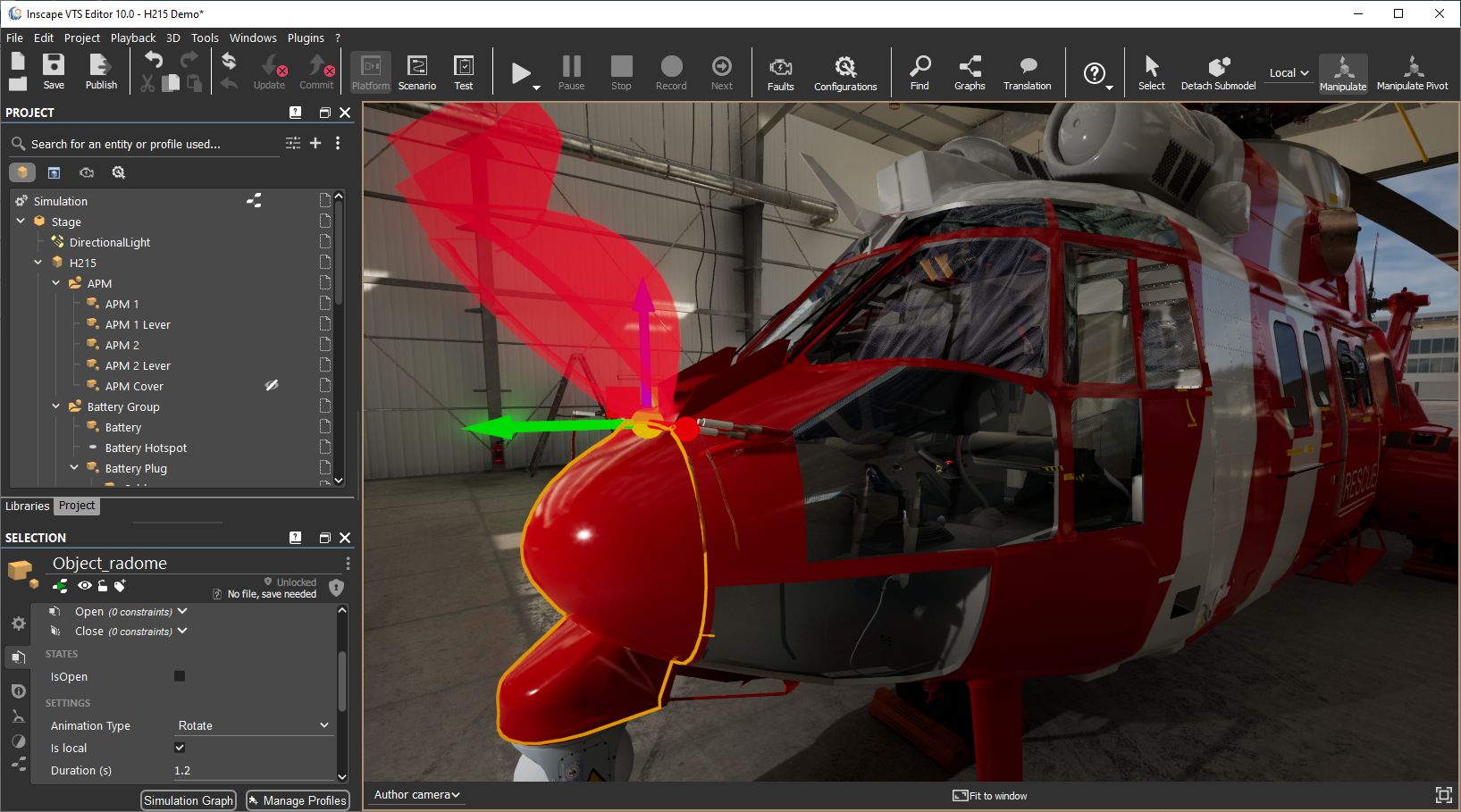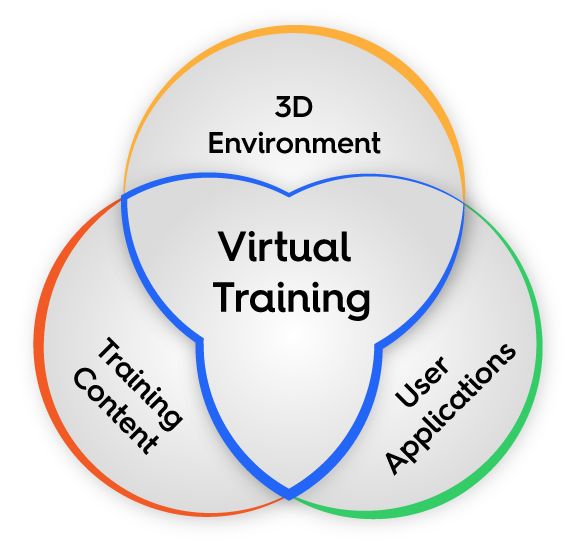In the first two parts of our series (part 1, part2), we explored the misconception that the 3D engine is the most critical component in developing a training simulator and highlighted the powerful capabilities of 3D engines like Unity and Unreal Engine in creating immersive virtual environments.
In this third part, we will examine the benefits of using a specialized development tool. We will look at how they can leverage 3D engines for modeling, real-time rendering, and cross-platform application development, while empowering content creators to model pedagogical behavior through its no-code authoring platform.

Benefits of a specialized development tool
A specialized development platform does not replace a 3D engine. Inscape VTS, for example, relies heavily on Unreal Engine in many aspects:
- The modeling of a 3D environment, including graphics, physics, and sound, is entirely in the hands of graphic designers via Unreal Editor. This includes the development of graphical effects and behaviors, such as synchronizing multiple particle systems to illustrate a leak in a circuit.
- The real-time rendering engine, including in the editor, ensures that these environments are visually stunning and immersive.
- The development of cross-platform user applications is managed by software engineers using C++ or graphical development tools like Blueprint. This allows for the creation of robust and versatile applications that can run on various devices and platforms.
Inscape VTS Editor, on the other hand, empowers content creators, instructors, or subject matter experts to model pedagogical behavior. This essentially brings the 3D environment to life in a way that would otherwise be completely inaccessible to them. By providing a range of dedicated features, Inscape VTS Editor allows these experts to focus on creating effective training scenarios without needing to delve into the complexities of programming or 3D engine intricacies.
This combination of a powerful 3D engine and a specialized development platform ensures that both the technical and educational aspects of virtual training are addressed effectively. While Unreal Engine handles the heavy lifting of rendering and application development, Inscape VTS Editor makes it possible for non-programmers to create and manage the educational content, making the entire process more efficient and accessible.
Ease of use
In the realm of content creation, efficiency and ease of use are paramount. That's why an authoring tool must be designed to empower content creators and eliminate the need for third-party programmers.
One of the standout features of Inscape VTS for instance is its no-code requirement. Instead of traditional coding, users can leverage dedicated programming paradigms such as non-linear scenario editors, state machine modelers, and data flow modelers. This approach not only simplifies the creation process but also makes it accessible to subject-matter experts without a technical background.
Moreover, Inscape VTS includes integrated 3D tools that streamline the workflow. These tools eliminate the need to switch to a 3D modeler or Unreal Editor for simple animations, which can disrupt the production flow. Authors can define and preview animations with just a few clicks, modify the hierarchy of parts, hide, move, make them transparent, or color them with ease, all without the need for a complex material editor.
Standardization
The key to streamlining content production is undoubtedly to standardize the way content is organized. Unlike Unreal Editor's Blueprints, Inscape VTS has different types of graphs, each with a specific role: graphical behaviors, freeplay simulation logic, scenarios and sub-scenarios, specific graphs to define the link between operation and state change, or the consequence and the resolution of a fault. Another example is the availability of dedicated tools to definition of a mechanical constraint, a variable configuration, a tool, and many other things that are systematically encapsulated in a relevant function, easily understandable by subject-matter experts.
The benefits of this standardization are multiple:
- It allows for mass production without having to worry about design.
- It enables quick understanding of what other authors have done, making it easy and fast to modify while limiting regressions.
- It provides complex functionalities without the user having to worry about them: for example, proper multiplayer functionality is naturally ensured by the specialization of different behavior graphs, each being executed on the correct device : server, player client. Similarly, the non-regression testing tool can also execute the correct graphs, skipping behavior blocks automatically based on their semantics if needed.
Leveraging proven software
Using specialized software offers a significant advantage over starting from scratch with a 3D game engine. Here’s how:
- Reduce the development time:Once the 3D environment is imported into Unreal Editor, it takes only a few hours or days to create the first interactive content with Inscape VTS. This rapid development cycle allows for quick deployment across multiple platforms, enabling immediate user feedback. This approach helps avoid the "tunnel effect" often seen in traditional software development, where long development times can lead to a disconnect between the developers and the end-users.
- Start from already existing application: Inscape VTS leverages established software and user applications, eliminating the need for specific development with its associated tests and fixes. This reliance on proven technology ensures stability and reliability, reducing the risk of bugs and errors that can arise from custom development.
- Benefit from comprehensive features:Specialized software like Inscape VTS offers a more complete set of features than if everything had to be developed from scratch. This comprehensive toolset allows for rapid evolution based on user feedback. It includes for instance advanced functionalities for instructors, networking capabilities, 2D interactions, and support for VR and AR.
Training content sustainability
Creating a training simulator involves several distinct aspects that must be carefully considered. Firstly, there is the broad category of 3D content, which includes animations, graphical and sound behaviors, and potentially multimedia content. Tools like Unreal Editor are perfectly suited for this task when used by a graphic designer. Secondly, there is the pedagogical content, which defines the exercises to be performed by the trainees, including expected actions and machine reactions. Lastly, there is the user interface (UI) aspect, which involves the hardware devices used, user interactions, and feedback. For this third aspect, Unreal Editor is also an excellent tool for a developer, allowing them to efficiently develop and modify user applications across different hardware and software platforms. These three components are typically handled by different profiles: graphic designer, pedagogical expert, and developer.

The different elements involved in the development of a Virtual Trainer
Using a specialized editor allows for a clear separation between content production and the application aspect. This separation is crucial for the longevity of the training content, as it allows for the independent evolution of both aspects. On one hand, it enables the adoption of new versions of user applications without impacting the content. On the other hand, it allows the content to evolve autonomously without concern for how it will be deployed and utilized.
Separating the 3D environment from the pedagogical content also offers a decisive advantage. In 3D software, behaviors are often grafted onto actors or game objects, making it very complicated to update the 3D environment (reimport, modify the hierarchy, etc.). In contrast, Inscape VTS does not alter the 3D environment. Even though users may feel like they are grafting behaviors (profiles) directly onto the 3D parts, the software actually establishes a weak link between behavior and 3D. This ensures true digital continuity: it is possible to update the 3D environment without losing any created content and without complex and risky manipulations.
Maximizing reusability
A key benefit of using a dedicated tool like Inscape VTS is the unparalleled reusability of the content created. When content is developed independently of user interactions and other application-specific elements, it opens up a multitude of possibilities for repurposing that content in various ways. For instance, a Virtual Maintenance Trainer (VMT) can be easily transformed into a Component Location tool or a field assistance tool with minimal additional effort. This is because the core content already encompasses a significant portion of the necessary knowledge.
Indeed, the true value lies in the content itself, rather than the final applications. Developing high-quality content is a time-consuming process, but once it is created, it can be leveraged across different applications without the need for extensive redevelopment. This is in stark contrast to applications developed for specific uses with a 3D engine platform, where the content is often tightly coupled with the application, making it difficult to repurpose.
Inscape VTS's no-code authoring tool is designed to facilitate this kind of flexibility. By allowing subject-matter experts to create and manage content without needing to worry about the underlying technical details, Inscape VTS ensures that the content remains adaptable and reusable. This not only maximizes the return on investment in content creation but also ensures that training programs can evolve and expand over time without being constrained by the limitations of the original application.


